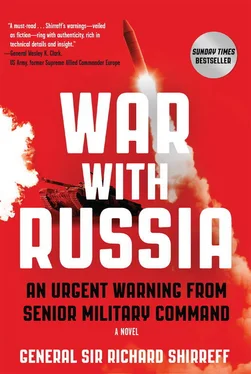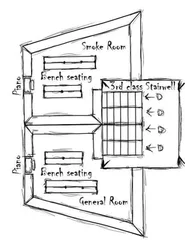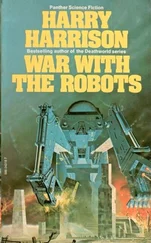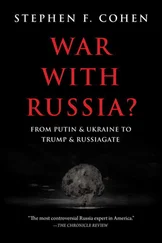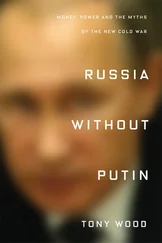He didn’t have long to wait. Mere moments later, he was conscious of a faint whispering sound and to his front, in the open field beyond the tree line, he saw the silhouette of a parachute descending rapidly with a helmeted, oxygen-masked figure wearing night vision goggles dangling beneath it, followed in quick succession by several more. The American Green Berets had arrived.
2330 hours, Saturday, July 8, 2017, Central European Time
0030 hours, Sunday, July 9, 2017, Eastern European Time
Comprehensive Crisis Operations Management Center (CCOMC) SHAPE headquarters, Mons, Belgium
IT HAD BEEN a long day but, nevertheless, the night shift of the CCOMC, the nerve center of NATO’s strategic headquarters, was a hive of activity. In the open-plan command center, staff officers from all the NATO member states and several partner nations, civilian staff with impressive academic credentials and representatives from well-established partners like the EU and UN humanitarian organizations, planned and executed the campaign to eject Russia from the Baltic states.
In the Operations Center, with its banks of computers, multiple media feeds from different 24-hour news channels and social media, and its real-time satellite and drone surveillance imagery, up-to-the-minute information was filtered, analyzed and disseminated to the Command Group and supporting staff. Plans were then made and direction passed down to the Joint Command HQs at Brunssum in the Netherlands and Naples in Italy, as well as to NATO’s Maritime Command at Northwood and Air Command at Ramstein in Germany.
In the brightly lit CCOMC Conference Room, Admiral Max Howard, NATO’s strategic commander, together with McKinlay and Major General Skip Williams, the youthful-looking American Deputy Chief of Staff Operations, were running through the sequence of events for the operation due to be launched imminently, early on Sunday morning.
Williams was talking. “As you’d expect, SACEUR, there continues to be serious push back from the staff at Air Command. For an operation of this magnitude they’d expect to have several days to implement the air campaign or, at the very least, a thirty-six-hour window to guarantee even half-effective suppression of enemy air defenses. So, the idea of mounting the whole operation over one short July night is a major concern for them. They’ve pointed out that every war in recent history, even establishing a no-fly zone against an enemy as useless as the Libyans, has depended on an air campaign lasting several days.”
“That’s the way it’s going to be, Skip.” Howard was firm. “We’re in a different type of war and the old norms don’t apply here. An extended air campaign followed by a major land operation is old thinking. It’s exactly what the Russians will expect. We’ve got to be more agile. We know the integrated air-defense system covering Kaliningrad and Eastern Europe is exceptionally capable. I’m very aware that their S-400 system has missiles capable of engaging out to four hundred kilometers and they have shorter-range missiles for killing fast, maneuverable targets, so the Russians have the potential to make our air forces” job about as difficult as it can be.
“However, our aircraft are world beaters, so I’m confident that with F-22A Raptors and the B-2A Spirit Stealth bombers leading the way, we’ve got the capability to carve holes in the Russian air defenses to allow our other bombers through to attack targets on the ground. And don’t forget the new version of HARM, the High-speed, Anti-Radiation Missile our aircraft are carrying. The GPS allows it to pinpoint the location of the SAM, surface-to-air missile, radar emitters. Even if they switch off their radars, it will still hit them smack on the nose.”
McKinlay was impressed. He had not expected Howard to be so well-briefed on technical issues.
But then , he thought to himself, as an ex-naval aviator who had commanded a carrier battlegroup, he shouldn’t have been surprised . This technical stuff was essential bedside reading to aviators.
Howard continued. “But the bottom line is this. I’m counting on surprise and concentration of force in one massive attack by air, and Tomahawk missiles from the sea, to neutralize the Russian capability. And, of course, the key to it all is when the Brits activate Rasputin. The Russians won’t know what the hell is happening. Except that there will be a total collapse of their integrated air-defense system, as well as their nuclear and other command and control systems.”
“We know that, Sir. But the problem is Com Air, the Air Commander, at Ramstein doesn’t. He thinks he is putting his people into a suicide mission,” pointed out Williams. “In fact, ‘taken leave of our senses’ was one of the milder expressions he used. Couldn’t we… ?”
“Skip, I get it,” Howard interrupted. “I’ve spoken to him. We’re old buddies. But rightly, the Brits are keeping the circle of those in the know ultra-tight. God forbid, but they may need to use Rasputin again in the future, so we have to keep its very existence contained. I’ll have another word with him to reassure him… And of course it’s tough for those flyers. But that’s the way it’s got to be.”
The direction for McKinlay had been very clear—only Howard and Williams were cleared to be briefed about Rasputin and the circle was not to be widened. Even the SHAPE Chief of Staff, General Klaus Wittman, a German, was not being brought into the secret. But under the so-called “two eyes” protocol, such sensitive intelligence could only be shared between the British and Americans, and then only those with an absolute need to know. Such restrictions created real resentment in an Alliance where shared endeavor was a fundamental principle; particularly for the French, who complained bitterly about this privileged Anglo-Saxon club.
“We need to move on, Skip. Run me through the sequence again.”
Williams pressed the switch on the remote control and ran through a series of briefing slides. Once Rasputin had been activated by a phone call from McKinlay to GCHQ direct, the window of opportunity was uncertain. The briefing at GCHQ from Allenby had been very clear and had not changed: Rasputin would have a devastating impact on all Russian command and control systems, integrated air-defense and nuclear included, but it was uncertain how long it would be sustainable.
The most GCHQ felt able to guarantee was an eight-hour window—and even that was assuming an hour or two of confusion while the Russians worked through what was happening in the middle of the night and then started to fix the bug—after which the Russians would regain control of both their air-defense and nuclear systems. Hence the critical importance of the short, sharp operation to suppress Russian air defenses.
“We estimate that in the JOA, the Joint Operational Area, the Russians have got somewhere in the region of three hundred SAMs, organized into over a hundred firing batteries, with approximately five thousand Anti-Aircraft Artillery, supported by hundreds of overlapping early-warning, search-and-acquisition radars,” continued Williams. “That means that, once Rasputin is activated, there’ll need to be a constant flow of allied aircraft pouring over southern Lithuania, Kaliningrad and western Estonia to hit the batteries and other ground assets while the C2 is down. The targeting has been done very precisely and, as long as we achieve surprise, the Joint Force Air Component Commander, the JFACC, will be able to achieve air superiority before the air assault goes in.
“I’m not sure who’ll be more surprised: the Russians when their systems crash, or our flyers when they find they’ve got an open door and no incoming SAMs. Or, let’s put it like this, no coordinated SAM defenses. It’s entirely possible that individual batteries may be able to go into manual override and fire on their own initiative. Which raises a rather juicy prospect.”
Читать дальше
